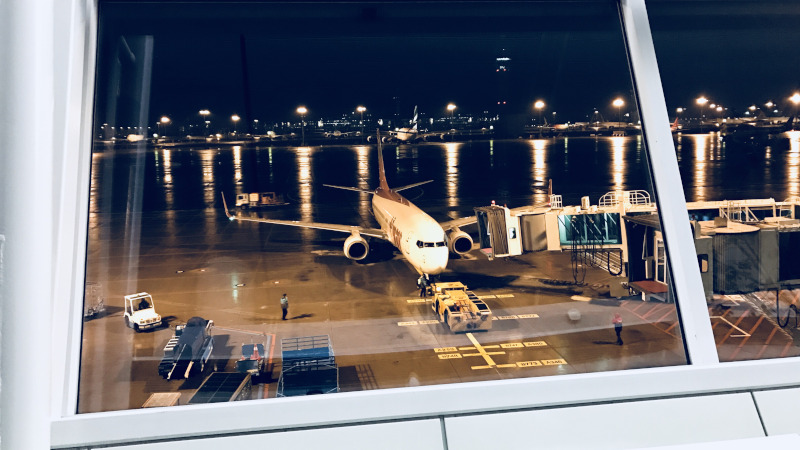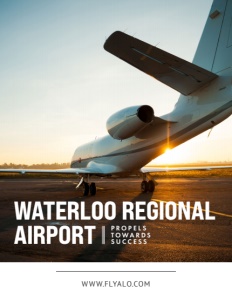Waterloo Regional Airport
Waterloo Regional Airport propels success
Revving the economic engines of Iowa and beyond
WATERLOO, IOWA—As ABBA once sang, “At Waterloo, Napoléon did surrender.” If you come to the eighth biggest city in the Hawkeye State, home to some 68,000 folks, you, too, will surrender to the charms of this lovely, progressive and prosperous community on the banks of the Cedar River. Helping propel the city to economic success is the Waterloo Regional Airport.
We recently spoke with Waterloo Regional Airport Director Keith Kaspari, Mayor Quentin Hart and City of Waterloo Community Planning and Development Director Noel Anderson. They told us more about the latest developments at the 2,600-acre airport and the important role it plays in the region’s economy, serving some 400,000 residents in Waterloo, Cedar Falls, Hudson, Gilbertville and places far beyond, attainable in a 14-county catchment area across the wild, blue yonder.
Like most such airports, it began its life of service for military purposes during World War II and subsequently transitioned to civilian use, complete with two runways and much more, as Kaspari explained. He added that the airport has enjoyed significant upgrades over the past 10 to 15 years. It features service to Chicago’s O’Hare International Airport, with an average of two daily flights, and many points elsewhere via American Airlines.
Kaspari praised Anderson’s efforts, re both the airport and the greater Waterloo community. Anderson himself offered further explication.
“The city of Waterloo has several development areas throughout the community,” he informs. “We actually have nine TIF (tax increment financing) districts, which gives us a little bit more flexibility for incentives and making infrastructure improvements in those areas. One of our main areas is the Waterloo Regional Airport area, where we’ve gone through the process of releasing FAA (Federal Aviation Administration) land that wasn’t needed for airport operations, and we’re creating a pretty large industrial park out there and seeing great success.”
 Kaspari informed that Livingston Aviation is the airport’s FBO or fixed-base operator.
Kaspari informed that Livingston Aviation is the airport’s FBO or fixed-base operator.
“Livingston Aviation has provided service to the Waterloo Regional Airport for going on 25 years now,” he reveals, “and they provide the full range of pilots’ services. They
provide fueling and maintenance, de-icing services during the winter season and hangars for those that need hangar storage overnight. They provide the full range of pilot services in the general aviation terminal building. They also do flight training. That’s getting to be a much more popular concept for FBO operators and in general, due to the nationwide need and shortage of pilots. They do a nice job for us.”
Kaspari continued that the airport’s two asphalt runways are respectively 8,400 feet and just more than 6,000 feet in length. Both are 150 feet wide.
“We’ve got a full hangar complement today,” he adds. “We have no openings. We could probably build some hangars if we have the opportunity to do that. We’ve got a number of hangars that we leased to Livingston Aviation for storage of based aircraft here.”
Some 73 aircraft are based at Waterloo Regional. This includes two relatively new private corporate hangars on long-term extended leases. Then there are the fueling facilities and bulk-fuel storage facilities, Kaspari notes.
“We feel good about the airfield’s infrastructure,” he says, citing FAA support and adding, “We’ve got a good infrastructure of two runways and adjoining or adjacent taxiways to provide a solid airfield base of pavements to current aircraft operators today.”
Kaspari returned to the topic of the nationwide pilot shortage. The pandemic played a big part in that. What can be done to address this crisis of numbers?
“This is my honest opinion,” says Kaspari. “It starts in Washington with good policy. If you’re prior military, they’re probably going to waive a number of hours, but you need 1,500 hours today as an airport transport pilot or ATP to jump into an air carrier cockpit. When the pandemic did occur, my understanding is that, as regards the folks in Washington with the funding assistance to the major air carriers, there was a significant retirement of both pilots and the crews, of course, and then also flight attendants and mechanics. Industry-wide, there was a significant shortage. They’re filling the vacancies now with the regional airlines and leaving communities not as well staffed with regard to the pilot ranks as regional airlines would like to have, because I’m sure they would like to as we continue to get a little bit further away from the pandemic.”
Still, he adds, headway is being made, though he doesn’t see the pilot shortage ending any time soon.
Looking very good
The Waterloo Regional Airport, as Kaspari points out, is a state-of-the-art facility. Everything looks very good indeed for this top-notch regional facility.
“We take a great deal of pride in maintaining our City facilities,” says Kaspari, “whether it’s the airport passenger terminal on the airport grounds, the general aviation passenger terminal or other facilities: Waterloo City Hall, public works, the library, the Waterloo Convention Center or the Waterloo Center for the Arts. We’ve got a number of highly dedicated department heads that maintain their City facilities in very good shape.”
He describes the Waterloo Convention Center as a very beautiful place, and he states further that Waterloo residents take a great deal of civic pride in these facilities owned by the City.
Hart shared that assessment. The Mayor also cited the local business park: Waterloo Air and Rail Park.
“We have a good relationship with Canadian National Rail out there,” says Hart. “Plus, we do have the spacing and the ability to design it for direct access to the taxiways and runways for airport-related industries.”
This new business park’s purpose is to make even greater use of the system of highways and railways that are near to the Waterloo Regional Airport and of course the latter’s runways. This 12-lot industrial park of some 400 acres is bordered on the west by the Waterloo city limits and Leversee Road and to the east by the airport runways. The City secured a release from the FAA to develop the land, and it earned a grant from the Iowa Department of Transportation to build a road.
Anderson says there is much potential there for air development. It will also, he adds, be very attractive to potential businesses that might be interested in locating facilities in Waterloo.
“I would say that we have land available there, from an economic development standpoint, for airport-related industries,” says Anderson. “As Keith has noted, we have the runway lengths (meeting the requisites for corporate jets), and we have the design capabilities with our engineering group to help put companies out there that would better utilize our airport for commercial uses, as well as the current residential uses.”
 It has it all
It has it all
Hart emphasizes that Waterloo Regional offers both convenience and access to the entire world, thanks to its partnership with American Airlines. The Mayor also extols Livingston Aviation for its excellence in service.
“We have an incredibly well-run airport,” says Hart.
Kaspari cited the airport’s many ongoing development efforts, such as the removal of sapling trees from the approaches to runways (a common and recurring problem for regional airports that requires a constant vigilance and mitigating efforts), and he lauds Anderson for his help.
“Over the last number of years,” Kaspari informs, “we’ve done a number of development projects out here. I’m trying to keep up with Noel on his City side! With regard to tree removal, they call it ‘obstruction mitigation,’ so we did that across (nearby) Dunkerton Road.”
One runway benefitted from the removal of a number of trees to its approach. Then there was a number of projects in a multi-project FAA-funded effort with regard to air-cargo apron reconstruction. At airports, aprons are flight lines or ramps: the area of an airport where aircraft are parked, unloaded or loaded, refueled, boarded or otherwise maintained.
Kaspari continues that Waterloo Regional Airport is slated to make in excess of $5 million in improvements and equipment acquisitions between this year and the next. The airport benefitted this year from more than $2 million from an American Rescue Plan Act (or ARPA) grant that facilitated the repaving of areas of the passenger parking lot and installing canopy structures and LED (or light-emitting diode) light fixtures. Jetway renovations and other facility improvements were also made possible. Kaspari adds that through 2026, the airport plans to spend $1 million for upgrades on an annual basis, which in turn will be added to the $1 million annually received from the FAA.
Hart sums up his community’s airport with great enthusiasm.
“The Waterloo Regional Airport,” he declares, “has it all!”
AT A GLANCE
Waterloo Regional Airport
What: a public-use, regional airport that serves Iowa, the Midwest and beyond
Where: Waterloo, Iowa
Website: www.flyalo.com
PREFERRED VENDORS
Stickfort Electric Company – stickfortelectric.com
From Aircraft Hangars and Industrial Production to Business Retail and Private Residences, Stickfort Electric is the Contractor of Choice.
We specialize in Design Build to meet your unique needs and expectations,
Details are as important to us as they are to you.


